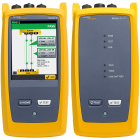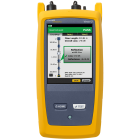Perda por inserção vs. Perda de retorno
14 de agosto de 2024 / Geral, fundamentos de aprendizado, instalação e teste
Perda de inserção e perda de retorno são dois dos parâmetros de desempenho mais críticos para links de cabeamento de cobre de par trançado e de fibra óptica. Eles representam aspectos distintos da transmissão de sinal e diferem entre os dois tipos de mídia. Aqui explicamos as principais diferenças entre esses dois parâmetros, por que eles são importantes e como interpretá-los.

Qual é a diferença entre Perda de Inserção e Perda de Retorno?
Perda de inserção é a energia que um sinal perde à medida que é transmitido ao longo de um link de cabo. É um fenômeno natural que ocorre para todos os tipos de sinais, ópticos ou elétricos. Essa perda de sinal, também chamada atenuação, aumenta com o comprimento. Pontos de conexão ao longo do link de cabo, incluindo conectores, divisores e emendas, também causam perda de inserção. A perda de inserção é medida em decibéis (dB) como um número positivo.
- • Em sistemas de cabeamento de fibra óptica, o excesso de perda de inserção pode ser causado por componentes de qualidade inferior ou instalação inadequada, como extremidades de fibra contaminadas, desalinhamento de conectores ou raio de curvatura da fibra excedido.
- • Em sistemas de cabeamento de cobre, a perda de inserção aumenta com a frequência e depende em grande parte do tamanho do condutor. Quanto maior for o calibre do condutor, menor será a perda de inserção. Temperaturas mais altas também podem aumentar a perda de inserção em sistemas de cabeamento de cobre, o que se torna uma preocupação maior em feixes de cabos que transportam mais de 60 W de Power over Ethernet (PoE). Saiba mais sobre perda de inserção e suas causas.
Em contraste, perda de retorno é a quantidade de sinal refletida de volta para a fonte transmissora. Ela é medida pela comparação da potência do sinal de entrada com a quantidade refletida. Como a perda de inserção, a perda de retorno também é medida em decibéis (dB) como um número positivo. Mas, diferentemente da perda de inserção, valores maiores de perda de retorno são melhores, se nenhum sinal for refletido, haverá uma perda de retorno infinita.
- • Em sistemas de cabeamento de fibra, a perda de retorno é causada principalmente por reflexões em pontos de conexão. É por isso que os fabricantes de conectores especificam a perda de retorno para seus conectores de fibra específicos. Extremidades de conectores contaminadas, lacunas e desalinhamentos também podem causar reflexões de sinal. Impurezas na fibra introduzidas durante a fabricação, bem como rachaduras, pontas abertas e raio de curvatura da fibra excedido podem piorar a perda de retorno.
- • Assim como a perda de inserção, a perda de retorno piora com frequências mais altas em links de cabeamento de cobre. Ela é causada por incompatibilidades de impedância entre componentes ou pequenas variações de impedância ao longo do comprimento do cabo. Para obter melhor perda de retorno, os fabricantes de cabos e conectividade de cobre projetam plugues e conectores com impedância correspondente, além de controlar a uniformidade durante todo o processo de fabricação do cabo. A perda de retorno em sistemas de cabeamento de cobre também pode ser causada por cabos dobrados ou danificados, ou por práticas de terminação inadequadas, como destorção desnecessária de pares em pontos de terminação. Saiba mais sobre perda de retorno e suas causas.
Por que a perda de inserção e a perda de retorno são importantes?
Perda de inserção e perda de retorno são importantes indicadores da integridade de um sistema de cabeamento.
- • Se a perda de inserção for muito alta, o sinal de transmissão pode não ter força suficiente na extremidade distante de um link para ser interpretado com precisão pelo equipamento ativo. Isso pode levar à degradação do desempenho ou fazer com que o link não funcione. É por isso que os padrões da indústria especificam limites de perda de inserção para aplicações de fibra específicas e categorias de cabeamento de cobre.
- • A perda de retorno é um parâmetro essencial porque os sinais refletidos podem interferir nos sinais de transmissão. Uma perda de retorno baixa também significa menos energia disponível na extremidade do cabo, o que pode causar perda de inserção. Em outras palavras, um valor maior de perda de retorno geralmente está correlacionado a um valor menor de perda de inserção. Em sistemas de cabeamento de cobre, a perda de retorno é essencialmente uma medição de ruído. A baixa perda de retorno em sistemas de cobre aumenta a diafonia, distorce os sinais e causa taxas de erro de bit.
Como interpretar perda de inserção
A perda de inserção é o principal parâmetro medido ao realizar testes de certificação de Nível 1 para sistemas de fibra, conforme descrito nos padrões de cabeamento TIA e ISO e é exigido pelos fabricantes de cabeamento e conectividade para receber uma garantia do sistema. A perda de inserção é medida em um link usando um Optical Loss Test Set (OLTS) como o Fluke Networks CertiFiber® Pro. O OLTS emite uma fonte de luz em uma extremidade de um link e usa um medidor de potência na outra extremidade para medir o sinal recebido e compará-lo com a quantidade emitida. Se a perda de inserção não for aprovada no teste de certificação com um OLTS, um Reflectômetro Óptico de Domínio de Tempo (OTDR) como o Fluke Networks OptiFiber® Pro OTDR pode medir a perda de eventos específicos, como quebras, dobras, emendas e conectores. Isso pode ajudar a determinar a causa e a localização exata do evento de perda. Saiba mais sobre o relacionamento entre um OLTS e OTDR.
O procedimento principal para testar perda de inserção em sistemas de fibra é o método de um jumper. Isso inclui a perda do primeiro e do último conectores, que representam como a rede de cabeamento será usada. Em sistemas de fibra multimodo, o teste de perda de inserção requer condições de lançamento de fluxo circundado (EF), que controlam como a luz é lançada na fibra para evitar um lançamento supercarregado, que pode levar a resultados pessimistas, ou um lançamento subcarregado, que pode levar a resultados otimistas.
A perda de inserção também é um parâmetro de desempenho essencial necessário para testes de certificação de cobre e obtenção de garantia do fabricante. Ele é testado usando um testador de certificação de cobre como o Fluke Networks DSX CableAnalyzer™ Series, que testa a perda de inserção em toda a faixa de frequência de cada par para o tipo específico de cabeamento de cobre. Por exemplo, em um sistema de Categoria 6, a perda de inserção é testada de 1 a 250 MHz, enquanto em um sistema de Categoria 6A, ela é testada de 1 a 500 MHz.
Saiba mais sobre teste de perda de inserção em sistemas de cabeamento de fibra e cobre.
Como interpretar a perda de retorno
Em sistemas de fibra, a perda de retorno é medida em um link usando um OTDR como o OptiFiber Pro. O OTDR transmite pulsos de luz de alta potência para a fibra. Quando esses pulsos encontram eventos reflexivos (por exemplo, conexões, quebras, rachaduras, emendas, curvas acentuadas ou a extremidade da fibra), eles são refletidos de volta e medidos. O total de toda a luz refletida de todos os eventos e o retroespalhamento total do link resulta no valor total de perda de retorno do link. Observe que um OTDR também pode fornecer valores de refletância e localização para cada evento individual. Entretanto, a refletância é o inverso da perda de retorno e um número negativo. Saiba mais sobre a diferença entre perda de retorno e reflectância.
A perda de retorno é um parâmetro de desempenho necessário para testes de certificação de cobre e obtenção de garantia do fabricante. Como a perda de inserção, ela é testada em toda a faixa de frequência para cada par usando um testador de certificação de cobre, como o DSX CableAnalyzer. A perda de retorno com falha em apenas um ponto de frequência geralmente indica um problema no cabo. Quando todos os quatro pares estão falhando (particularmente em frequências mais baixas), isso pode indicar um cabo de baixa qualidade ou água no cabo.
Saiba mais sobre teste de perda de retorno em sistemas de cabeamento de fibra e cobre.









